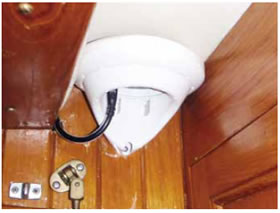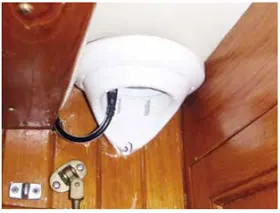
In a nutshell, autopilots have one main function: to assume control of a vessels steering and control its heading, be it a specific course or on a selected route or to a waypoint. As with any crucial piece of gear (anchors being a great example), cost should not be the primary consideration in the selection process. Its crucial to select a unit that has both the power and ability to steer your boat effectively in all sea conditions youre likely to encounter.
Autopilot manufacturers provide guidelines for product selection, but always be conservative and go up in size when in doubt, particularly if extenuating circumstances apply (heavy displacement, full keel, greater spread of canvas, etc). Heading into rough weather with a seasick crew is not the time to find out your choice of autopilots is lacking.
Remote Wireless Controls
Many autopilot manufacturers offer wireless remote controls as an optional accessory. These can be anything from simply left/right controls to various modes that allow you to do anything from choose steering patterns (from zig-zags to clover leafs) to entering a command to dodge an obstacle and resume course afterward.
Our previous system included a Raymarine S100 wireless controller, and we were able to incorporate it into the new EV-1 installation, although it required the use of a SeaTalk NG networking adaptor/converter. Our testers found it a great benefit (particularly while single handing) while raising sails, picking up a mooring ball, or during visual navigation while in the Bahamas.
Installation Tips
Thoroughly plan out the entire installation (from drive integration to mounting the display) before picking up that first tool.
Avoid installing fluxgate compasses near large pieces of metal or placing magnetically charged items (like handheld electronics and speakers) near the unit.
All power-supply wiring needs to be conservatively sized. Refer to a voltage-drop table to estimate the amount of drop from the battery to the drive unit, which is the most power-hungry element in the system.
If youre not comfortable installing the system yourself, at a minimum watch the technician install it. Its not rocket science, and everything you learn will help to troubleshoot and hopefully repair the unit should it fail.



































That’s the article on Autopilots that’s it?… Some platitudes and $.10 of advice what a waste of a subscription.
Peter I agree with your comment. A good autopilot is one of the most important pieces of gear for shorthanded sailing. I am disappointed that this all the PS has to say on this topic.
Thank heavens for YOUtube
This is a free article open to the public. It is a sidebar to of a larger report from our archives that ran in the April 2014 issue. If you conduct a search “autopilot” or other relevant words, you’ll find quite a bit more. https://www.practical-sailor.com/?s=autopilot
Thanks.